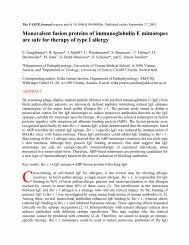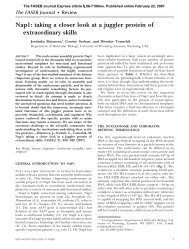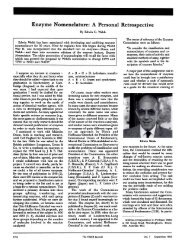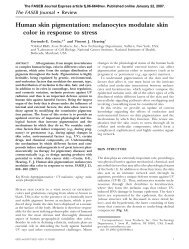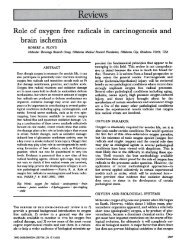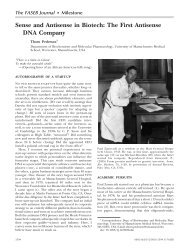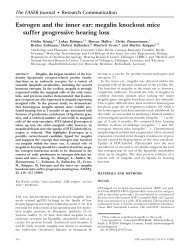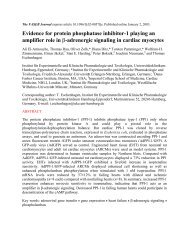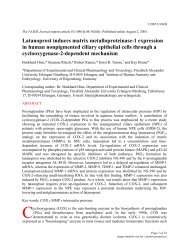(HSL) is also a retinyl ester hydrolase: evidence from mice lacking ...
(HSL) is also a retinyl ester hydrolase: evidence from mice lacking ...
(HSL) is also a retinyl ester hydrolase: evidence from mice lacking ...
Create successful ePaper yourself
Turn your PDF publications into a flip-book with our unique Google optimized e-Paper software.
genic process (11). Low doses of RA, however, have<br />
been shown to promote preadipocyte differentiation<br />
(12). RA <strong>is</strong> believed to exert its effects on adipogenes<strong>is</strong><br />
mainly through its role as a ligand for the retinoid X<br />
receptor (RXR), which heterodimerizes with perox<strong>is</strong>ome<br />
proliferator-activated receptor � (PPAR�), the<br />
crucial transcription factor for adipogenes<strong>is</strong> and survival<br />
of mature adipocytes (13, 14). RALD, which up to<br />
now was believed to play a role only in the eye, was<br />
recently shown to be a potent inhibitor of adipogenes<strong>is</strong>,<br />
operating through both RXR-dependent and RXRindependent<br />
mechan<strong>is</strong>ms (15).<br />
<strong>HSL</strong> <strong>is</strong> best known as a lipase hydrolyzing acylglycerides.<br />
Its role in catecholamine-stimulated hydrolys<strong>is</strong> of<br />
stored triacylglycerols and, in particular, diacylglycerols<br />
has been demonstrated in studies of <strong>HSL</strong>-null <strong>mice</strong> (16,<br />
17). Despite its prominent role in lipolys<strong>is</strong>, <strong>HSL</strong>-null<br />
<strong>mice</strong> are not obese and exhibit a remarkable res<strong>is</strong>tance<br />
to development of obesity following challenge with a<br />
long-term high fat diet (HFD) (18, 19). The res<strong>is</strong>tance<br />
to diet-induced obesity <strong>is</strong> accompanied by impaired<br />
adipogenes<strong>is</strong> (18, 19) and attainment of brown adipocyte<br />
features of WAT (18), suggesting that <strong>HSL</strong> plays<br />
additional, yet unexplored, roles in adipose t<strong>is</strong>sue. <strong>HSL</strong><br />
exhibits broad substrate specificity and besides acylglycerides<br />
it hydrolyzes chol<strong>ester</strong>yl <strong>ester</strong>s, REs, lipoidal<br />
<strong>ester</strong>s, and water-soluble <strong>ester</strong>s. The biological significance<br />
of these other activities, however, <strong>is</strong> poorly understood.<br />
Results <strong>from</strong> studies using partially purified<br />
preparations of <strong>HSL</strong> as well as transfected CHO cells,<br />
have indicated that the REH activity of <strong>HSL</strong> <strong>is</strong> approximately<br />
one tenth of the activity against triacylglycerol<br />
(7). Furthermore, following stimulation of cultured<br />
adipocytes with dibuturyl cAMP, ROH was released to<br />
the medium in parallel with decreased RE stores of the<br />
cell, suggesting that a cAMP-regulated enzyme, such as<br />
<strong>HSL</strong>, <strong>is</strong> responsible for th<strong>is</strong> mobilization. The biological<br />
significance of <strong>HSL</strong> as an REH in adipose t<strong>is</strong>sue has,<br />
however, never been directly addressed. We therefore<br />
utilized purified preparations of recombinant <strong>HSL</strong>, as<br />
well as <strong>HSL</strong>-null <strong>mice</strong>, to investigate the REH activity of<br />
<strong>HSL</strong> and the consequences of <strong>HSL</strong> deficiency for ROH<br />
metabol<strong>is</strong>m in adipose t<strong>is</strong>sue.<br />
MATERIALS AND METHODS<br />
Animal experiments<br />
The study was reviewed and approved by the Ethical Committee<br />
in Malmö/Lund, Lund, Sweden (license no. M162-05)<br />
and <strong>is</strong> in accordance with the Council of Europe Convention<br />
(ETS 123). <strong>HSL</strong>-null <strong>mice</strong> were generated by targeted d<strong>is</strong>ruption<br />
of the <strong>HSL</strong> gene in 129SV-derived embryonic stem cells<br />
as described elsewhere (16). Animals used were <strong>from</strong> the<br />
same embryonic stem cell colony. Animals in the different<br />
groups were littermates and had a mixed genetic background<br />
<strong>from</strong> the inbred strains C57BL/6J and SV129 (16). The<br />
animals were maintained in a temperature-controlled room<br />
(22 � C) on a 12-h light-dark cycle. Mice, 16–20 wk of age, were<br />
fed a chow diet ad libitum (control) (11% energy <strong>from</strong> fat) or<br />
a high-fat diet (HFD) (58% energy <strong>from</strong> fat) (Research Diets;<br />
products D12310 and D12309, respectively; Research Diets,<br />
New Brunswick, NJ, USA). After sacrificing the <strong>mice</strong>, t<strong>is</strong>sues<br />
were rapidly d<strong>is</strong>sected, snap frozen, and stored in liquid<br />
nitrogen before in vitro analyses.<br />
For the diet intervention studies, regular HFD (see above),<br />
containing 0.8 g/kg diet of <strong>retinyl</strong> palmitate, and <strong>retinyl</strong><br />
<strong>ester</strong>-free HFD, supplemented with 10 mg all-trans retinoic<br />
acid (atRA)/kg diet (product D05081101), were obtained<br />
<strong>from</strong> Research Diets. The studies were initiated by feeding<br />
mating <strong>mice</strong> the two respective diets. Thus, diets were provided<br />
<strong>from</strong> pregnancy to weaning of the pups and maintained<br />
until the age of 5 mo, after which the <strong>mice</strong> were killed and<br />
t<strong>is</strong>sues were d<strong>is</strong>sected. Mice fed the atRA-supplemented diet<br />
were divided into three groups; one group was fed the higher<br />
concentration throughout the entire study, and two groups<br />
were initially fed the higher concentration, but after 2.5 mo<br />
were switched to a diet containing 1 and 0.5 mg atRA/kg diet,<br />
respectively, by mixing the original atRA-containing diet (10<br />
mg/kg diet) with <strong>retinyl</strong> <strong>ester</strong>-free HFD. Body weight and<br />
food intake were measured throughout the study. Blood<br />
samples were drawn by retro-orbital puncture <strong>from</strong> female<br />
animals in the fed state.<br />
Recombinant <strong>HSL</strong> and enzyme activity measurements<br />
Recombinant rat and human <strong>HSL</strong>, purified to apparent<br />
homogeneity (�95% protein purity) (20–22), were assayed<br />
against trioloein (TO), 1-mono-oleoyl-2-O-mono-oleylglycerol<br />
(MOME, a diolein analog), chol<strong>ester</strong>yl oleate (CO), and<br />
<strong>retinyl</strong> palmitate (RP) substrates, as described previously (20,<br />
23, 24). Briefly, unlabeled and labeled substrates were emulsified<br />
with phospholipids in 100 mM KH 2PO 4 (pH 7.0) and<br />
5% defatted BSA (fatty acid acceptor) using sonication, to<br />
yield final substrate concentrations of 5 mM (TO and<br />
MOME), 0.45 mM (CO), and 0.5 mM (RP). The purified<br />
enzyme preparations were in 5 mM NaH 2PO 4 (pH 7.4), 1 mM<br />
dithioerythritol, 50% glycerol, and 0.2% C 13E 12 (a detergent<br />
<strong>from</strong> the polyoxyethylene series) and were diluted with 20<br />
mM KH 2PO 4 (pH 7.0), 1 mM EDTA, 1 mM dithioerythritol,<br />
and 0.02% defatted BSA to noninhibitory detergent concentrations<br />
before assay (23). Unit (U) <strong>is</strong> defined as micromoles<br />
of fatty acids released per minute at 37 � C.<br />
Determination of RALD and RA in WAT with LC-MS/MS<br />
To extract RALD and RA <strong>from</strong> WAT, 3 vol of 2-propanol<br />
containing a 13 C-labeled stable <strong>is</strong>otope of atRA as internal<br />
standard was added to WAT pieces (200 mg), followed by<br />
homogenization with a motorized homogenizer (Pro Scientific,<br />
Oxford, CT, USA), shaking for 15 min, and centrifugation<br />
(10 min, 10 � C, 2700 g). The whole procedure was<br />
performed under red light. An aliquot of 100 �l was analyzed<br />
on a 4000 Q TRAP LC-MS/MS, triple quadruple mass spectrometer<br />
with APCI ionization (Applied Biosystems, Foster<br />
City, CA, USA), as described previously (25) except that the<br />
separating column was a Supelco ABZ Plus, 70 mm � 3mm<br />
ID, 3-�m particles (Supelco/Sigma-Aldrich, St. Lou<strong>is</strong>, MO,<br />
USA). The additional MRM transitions monitored for retinal<br />
were 285.2-161 (quantifier) and 385.2-133 (qualifier).<br />
Determination of ROH in plasma and WAT, and RE in<br />
WAT using LC-UV<br />
One hundred microliters of plasma or �200 mg of WAT was<br />
diluted with 450 �l 2-propanol containing <strong>retinyl</strong> propionate<br />
as an internal standard and butylated hydroxytoluene as an<br />
antioxidant. After thorough mixing (15 min) and centrifugation<br />
(10 min, 4000 g at 10 � C), an aliquot of 20 �l was injected<br />
2308 Vol. 23 July 2009 The FASEB Journal<br />
STRÖM ET AL.



